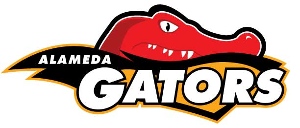Swim Meets are FUN!
Although Alameda Gators swimmers are not required to participate in swim meets, the coaches strongly encourage all swimmers to compete regularly. Coach Bret offered a great overview of why swim meets are good, fun and important and we encourage you to check it out if you haven't read it yet.
The Gators coaching staff determines which meets are appropriate for the team to attend and sets the year's meet schedule at the beginning of each season. See the Age Group Schedules and Senior Schedules for more details. On average, the team attends one meet per month. As a general rule we do not encourage going to meets on back-to-back weekends.
OUR PHILOSOPHY OF COMPETITION
The Gators have a multi-level competition program within United States Swimming that, like our training program, attempts to provide challenging yet supportive opportunities for swimmers of all ages and abilities.
Our philosophy of competition includes:
- Promoting competition with oneself. Winning ribbons, medals or trophies is not our main goal. Even if the swimmer finishes first, but swims poorly in comparison to his/her own past times, the swimmer in encouraged to do better. Conversely, if the swimmer reaches a personal best but does not win a ribbon or other award for that event, the accomplishment is celebrated. The individual’s improvement is our primary objective.
- Sportsman-like behavior is of equal importance to improved performance. Respect for officials, congratulations to other competitors, encouragement to teammates, determined effort, and mature attitudes are examples of behaviors praised and rewarded by the ALGA coaching staff.
- A swimmer is praised for improving his/her stroke time. It is the coach’s job to offer constructive criticism of a swimmer’s performance. It is the parent’s responsibility to provide love and encouragement that bolster the swimmer’s confidence along the way. Swimmers are taught to set realistic, yet challenging goals for meets and to relate those goals to practice to direct their training efforts.
- Swimmers are prepared and encouraged to compete in all swimming events, distance and strokes. This policy promotes versatility and encourages the swimmer to explore his/her potential in the swimming world.
LEVELS AND TYPES OF COMPETITION
There are seven age groups in Pacific Swimming: 8 and under, 10 and under, 11-12, 13-14, 15-16, 17-18, and senior. Occasionally, 6 and under events will be held, and swimmers 19 and over may compete, using 17-18 entry times, but they may not score points in meets. A swimmer’s age on the first day of the meet determines the age group events that the swimmer enters. Separate events are held for girls and boys, and swimmers only compete against others in their age/sex group.
Within each age group there are different ability levels or classifications. As of the 2019-20 swim season, Pacific Swimming uses the standard USA Swimming Age Group time classifications of C, B, BB A, AA, AAA, and AAAA. (“C” times represent the slowest time standards in any age group, while “AAAA” times represent the fastest.) Links to these time standards are available on the Pacific Swimming and USA Swimming websites. Pacific Swimming also sets its own minimum time standards for championship meets that it runs: JO (Junior Olympics), and FW (Far Westerns).
In order to swim in a certain classification, a swimmer must have achieved the minimum time established for that particular classification. A swimmer may be in different classes for different strokes (i.e. B for butterfly, AA for backstroke, FW for freestyle, etc.). These classes are mutually exclusive. Once a swimmer qualifies in a higher class for a particular stroke and distance (achieves an A time for example), he/she may not swim that stroke and distance in the lower class (as a B swimmer) until he/she changes age groups or the time standard is changed. This permits fair yet challenging competition at each level.
The various types of meets include:
- C/B/A+ meets- These meets are open to swimmers of all abilities and are ideal for new swimmers or newly aged up swimmers. Typically, all heats at a C/B/A+ meet are swum as finals (in swimming slang “timed finals”) and there are no preliminary races.
- B/A+ meets- Some age group meets are designated as B/A+ meets, which means that swimmers must have a minimum of a B time in each event that they enter.
- Junior Olympic Championships- Open to age group swimmers who have achieved a Pacific Swimming Junior Olympic (JO) time in any event. The JO meet is conducted with preliminary heats early in the day and finals in the evening. (“Trials and finals”)
- Far Western Championships- Open to age group swimmers who have qualifying Far Western (FW) times, as listed in the Pacific Swim guide or online at the Pacific Swimming web site. Like the JO meet, the Far Western meet is a trials and finals meet with preliminary heats early in the day and finals in the evening.
- Senior Meet- Swimmers must qualify with a “Senior” time standard as listed in the Pacific Swim guide or online at the Pacific Swimming web site. Senior meets are held at different levels (Senior Open, Senior II, and Senior Circuit) with different time requirements at each level. Some senior meets are held as timed finals and others are run with trials and finals.
- Sectional Championships- Swimmers must qualify with a “Sectional” time standard as listed on the USA Swimming website. Meet is held with trials and finals.
- Junior National Championships- Swimmers must qualify with a “Junior National” time standard as listed on the USA Swimming web site. Meet is held with trials and finals.
- Senior National Championships- Swimmers must qualify with a “Senior National” time standard as listed on the USA Swimming web site. Meet is held with trials and finals.
At the discretion of the head coach, the Gators may compete in Junior Olympics or another meet of equal prestige, during each swim season. Those meeting the junior national time standards will travel to various U.S. cities to compete with some of the best swimmers in the country.
The long-term goal of our team is to move swimmers on to compete in the Senior Nationals. Senior National times are the fastest time standards and allow for the highest level of competition for senior swimmers other than Olympic Games and World Championships. As with the junior national swimmers, those meeting the national time standards travel to various U.S. cities to compete against America’s best swimmers. By their performance in these meets, swimmers often qualify for United States teams that engage in international competition. For additional information about meets refer to the Pacific Swim Guide Rules and Regulations.





